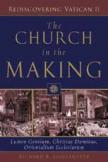Her Nature, Her Future
What are we to make of Vatican II? has become a central topic for contemporary theology and church life, both because the conciliar generation is dying off and because of the elevation of Joseph Ratzinger, a prominent theologian at the council, to the papacy. Paulist Press has undertaken an eight-volume series, Rediscovering Vatican II, to provide the church with a resource for answering that question. The series is in a sense an act both of ressourcement, returning to the conciliar debates and deliberations and the texts they produced, and aggiornamento, drawing on the council to point the way forward for today’s church. Each volume covers from one to three of the council’s 16 documents, and all have the same five-part structure:
1. A history of the formation of the documents;2. Major points of the documents;
3. The reception and implementation of the documents after the council;
4. The present state of the questions raised in the documents;
5. Suggestions for further reading.
Richard Gaillardetz’s volume is one of five published thus far. Its main focus is on Lumen Gentium, the Dogmatic Constitution on the Church, one of the council’s central documents, but it also examines two shorter, related documents, the Decree on the Pastoral Office of Bishops in the Church and the Decree on the Catholic Churches of the Eastern Rite. Gaillardetz, the Murray/Bacik Professor of Catholic Studies at the University of Toledo whose books include By What Authority?, facilitates reading on specific issues by dividing each of Parts 2, 3 and 4 of his book into subsections with the same three subheads: Theological Foundations of the Church, The Unity and Catholicity of the Church and Church Office and the Exercise of Leadership. He keeps many of his lesser subheads constant also.
No topic was more hotly debated at the council, Gaillardetz says, than episcopal collegiality, so let’s take that subhead as a sample of how he proceeds, though it is just one of many topics covered in his book. In the first part, Gaillardetz defines collegiality as the claim that all of the bishops, as an episcopal college,’ shared episcopal authority over the universal church with the pope, who as bishop of Rome was a member and head of this college. He traces this theme from its introduction in the second draft of the council’s schema on the church, through the debates about it on the council floor, to its expression in the final text of Lumen Gentium. In the second part, Gaillardetz notes two different versions of collegiality that the council set side by side without reconciling them. In one the college of bishops is set over the church. In the other, based in the council’s theology of the local church, each bishop represents his own church, and together the college is a concentrated manifestation of the universal church.
In the third part, Gaillardetz begins with Cardinal Léon-Josef Suenens’s argument (in a 1968 book) that every exercise of papal primacy is at least implicitly collegial. Pope John Paul II echoed Suenens’s position in several of his writings, notably his encyclical Ut Unum Sint (1995) on ecumenism. Yet by contrast, John Paul II’s exercise of papal authority often seemed thoroughly uncollegial. Gaillardetz also traces theological debates and church documents relating to the status of two institutional expressions of collegiality, namely, episcopal conferences and the World Synod of Bishops. In the fourth part, Gaillardetz develops an ecclesiology that gives priority to neither the universal church nor the local church. The bishop is ordained to serve the local church and is by that act made a member of the college of bishops as the sacramental embodiment of the communion of churches. Gaillardetz argues that the occasional and consultative World Synod of Bishops should be replaced by a standing synodal body, as in the eastern churches, that has deliberative authority. Episcopal conferences should have deliberative authority as well.
It becomes clear from Gaillardetz’s account that many of the divisions that have sprung up over the interpretation of Vatican II are based on false dichotomies. For instance, should the council be understood as an event or as a set of texts? Well, as we learn from both ancient rhetoric and modern speech-act theory, a set of texts is an event. It does things in the process of saying them, and what it does depends on who is speaking to whom in what circumstances. It was, for example, significant for ecumenism when the council deliberately chose to replace is with subsists in in the statement (in Lumen Gentium) that the church of Christ subsists in the Catholic church, even though is and subsists in have pretty much the same meaning in the dictionary. The distinction between the two terms is still being worked outthe event is not over yet.
There is no storm, no tsunami, in the postconciliar church as Gaillardetz portrays it. Squalls or waves (pick your metaphor) like Humanae Vitae or the sex-abuse crisis are mentioned only in passing, and the sharp drop in church involvement in Europe and North America, especially among the young, is not mentioned at all. Instead, Gaillardetz depicts a more or less continuous process of the church in the making both at the council and after it. The conciliar texts, he concludes, are best interpreted...as formal snapshots of a living church following the guidance of the Spirit into an unknown future.
I wish Gaillardetz had taken up the question of how far the reforms he proposes meet the challenges the church faces today. Even so, whether we are looking, as my former student may be, for shelter from the storm or, as I am, for hope in the face of the church’s failure to live up to the council’s ideals, Gaillardetz offers a timely reminder that the Spirit so much in evidence at the council is not finished with us yet.
This article also appeared in print, under the headline “Her Nature, Her Future,” in the April 16, 2007, issue.








